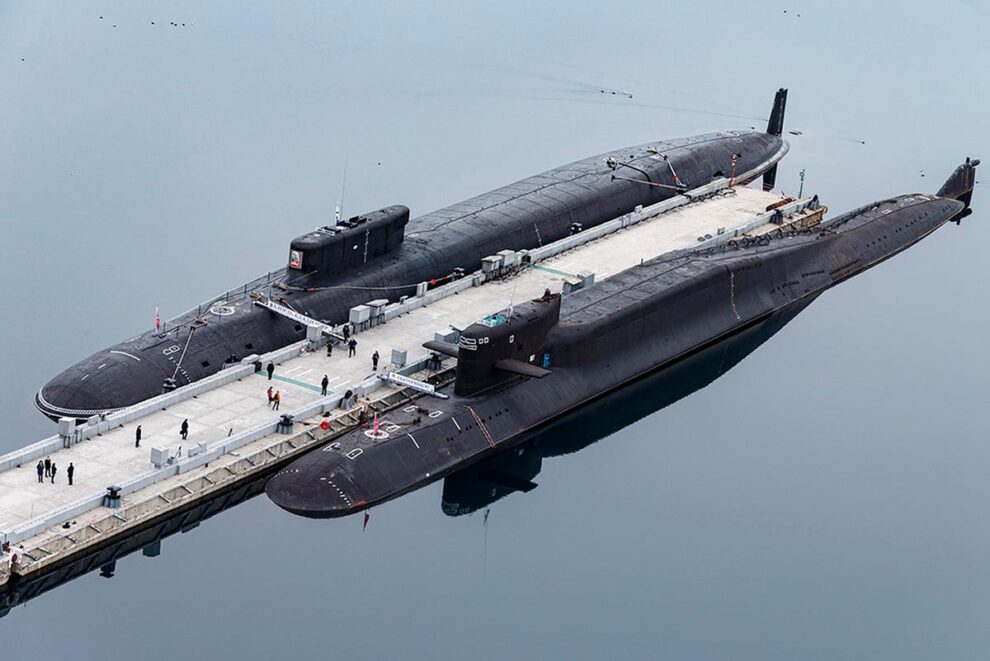Now that the basic outlines of the trilateral Australia-UK-US (AUKUS) Partnership on nuclear-powered submarines are open for public scrutiny, the ultimate response may well be a competing Russia-China bilateral undersea partnership. A proposal from China, a sort of “Anti-AUKUS” Axis, with Russia trading submarine technology for military aid, both rebuffs AUKUS and solves some urgent problems for both countries.
Proliferation of Russia’s nuclear submarine know-how—something Russia’s ruler Vladimir Putin has, up till now, refused to trade away—poses a real risk of complicating the West’s Indo-Pacific security framework, while Chinese military aid could make things difficult for Ukraine.
If Iran were brought in as well, completing a rival “Anti-AUKUS” trilateral partnership, the proliferation of Russian nuclear-powered submarine technology stands to spread chaos well beyond the Indo-Pacific and into the Middle East and Europe.
Mulling An Anti-AUKUS Axis:
China’s diplomatic response to AUKUS is becoming clearer by the day. Less than 24 hours after the AUKUS announcement, news broke that Chinese President Xi Jinping is planning to travel to Russia and meet with Putin as early as next week. An Iran visit is reportedly also in the works as well.
With AUKUS, clearly aimed at China—and giving the UK a lifeline to build more submarines to secure the North Atlantic—Putin, a martial arts aficionado, may find an attempt at a judo-like diplomatic reversal quite appealing. China’s diplomats, along with Li Shangfu, China’s new Russian-affiliated defense minister, will be glad to trade for Russian undersea technologies. Li, sanctioned by the U.S. for acquiring advanced Russian weapons for China, knows exactly what China needs from Russia’s decaying military arsenal.
All the pieces for an unprecedented technology transfer agreement are in place. China’s relationship with the U.S. is at a new low, and Russia, struggling in Ukraine, appears desperate enough to trade away nuclear-powered submarine technology, one of the few remaining areas of near technological parity with the West, for little more than a few artillery shells, some basic electronics, and commercial trinkets for Russia’s urban elites in Moscow and St. Petersburg.
With Australia set to host new undersea assets, backstopping visits by both U.S. and UK nuclear powered submarines at HMAS Stirling, a strategic Western Australia base near Perth, China needs modern nuclear submarine technology right away. The Chinese Navy is struggling undersea, with both their newest nuclear subs, the Shang class (Type 093) attack submarine and the Jin class (Type 094) ballistic missile submarines all noisier than Russia’s Cold War-era Akula I class and Oscar II class nuclear subs.
To put China’s poor technical performance in perspective, the first Akula entered Russian service in 1984, and the first Oscar II went online in 1986.
For China, the timing couldn’t be better. With China’s industrial base primed for a rapid submarine buildup, an injection of new Russian submarine technology is all China needs to jump-start an undersea arms race. In November 2022, Australian press reports warned, “the dry docks at China’s nuclear submarine facility at Huludao, Liaoning province, show increased activity. New construction halls are primed. Another dry dock is ready to go.”
Adding Iran may prove a bridge too far, but with Iran already supporting Russia’s war effort, supplying drones and other aid, adding a junior Middle Eastern partner to Russia and China’s “No Limits” bilateral offers Putin and Xi opportunities to further destabilize the existing Middle East geopolitical order.
The Consequences Of An Anti-AUKUS Alliance
An Anti-AUKUS agreement, coming so quickly after AUKUS, validates the West’s undersea technology alliance. AUKUS was crafted to manage China’s rise and prevent catastrophic Chinese overreach.
But a sudden China-Russia technical alliance complicates things. If confronted by a rapid Chinese buildup of modern, Russian-enhanced nuclear submarines, countries throughout the Indo-Pacific will be hard-pressed to respond. America’s long-term naval-building plans will be shelved as inadequate, and other Indo-Pacific stakeholders will need to quickly change their defensive posture.
Once new Chinese nuclear submarines start playing hide-and-seek in the Pacific, regional interest in nuclear submarines will skyrocket.
The AUKUS agreement, flexible enough to retain technical parity with a reasonably rapid advance of Chinese undersea technology, would be hard-pressed to keep up with a sudden explosion of Chinese variations of advanced Russian submarines.
To respond, Western democracies would need to accelerate far beyond the confines of the AUKUS agreement. With the proposed SSN-AUKUS submarine clearly positioned to be the West’s first standard export-oriented nuclear sub, India, Japan, Taiwan, South Korea, Singapore, Canada, and other Pacific democracies could be brought in as potential partners. By patterning the enormous project after the F-35 Lightning II, the SSN-AUKUS submarine may end up in far more places than originally envisioned in publicly-released AUKUS summaries.
For the U.S., any marriage of advanced Russian nuclear-powered submarine technology with China’s massive maritime fabrication capabilities is a tough pill to swallow. Top-tier Russian submarine technology already challenges America’s undersea dominance. With similar tech in China’s capable hands, tensions in the Pacific will skyrocket as China’s new Russian-enhanced nuclear subs start entering service.
For Iran, inclusion in a high-profile agreement with Russia and China offers a much-needed domestic boost, and the mere prospect of a modern Iranian nuclear submarine would raise tensions across the region.
For Russia, the transfer of nuclear submarine technology to China is a humiliating gamble.
Trading Russia’s technological crown jewels for little more than some 122 mm and 152 mm ammunition and a few Western computer chips catapults Russia into a client-state status with a resurgent China. But, outside of natural resources and territory, Russia has little else to offer China’s formidable President.
Once Russia’s technological edge is gone, it will not come back. An already weakened Russia, facing a massive, under-populated—and now unprotected—land border with China, counted on undersea supremacy as a way to check Chinese north-facing adventurism.
By ceding China dominance of the undersea domain, Russia’s sovereignty in the Northern Pacific and Arctic will be challenged, and with no measurable means to contest China’s coastline, Russia has few military options if relations with China sour over time.
Those contingencies may not matter to Putin. With a steady supply of ammunition, and the potential to quickly break Ukraine to Moscow’s will, Russia may write Siberia off, and simply focus on dominating Western Europe and the Mediterranean, where Putin’s heart, yacht, and vacation villa rest.
Source : Forbes










